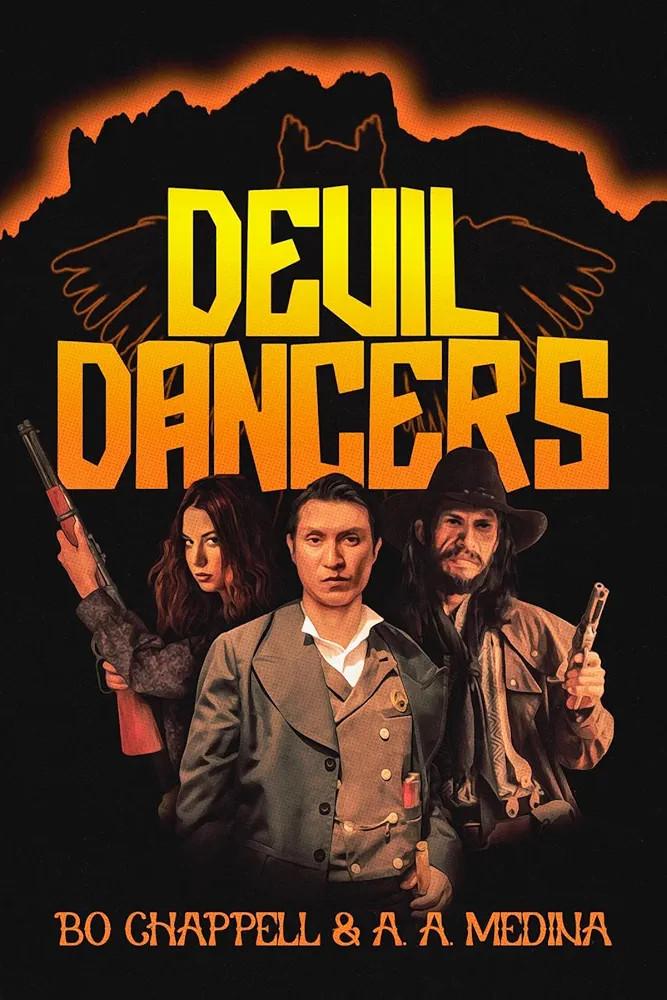You are here
Home › Books › Bo Chappell & A.A. Medina’s Horror-Western 'Devil Dancers' Puts The Wild Back Into The West ›Bo Chappell & A.A. Medina’s Horror-Western 'Devil Dancers' Puts The Wild Back Into The West
FTC Statement: Reviewers are frequently provided by the publisher/production company with a copy of the material being reviewed.The opinions published are solely those of the respective reviewers and may not reflect the opinions of CriticalBlast.com or its management.
As an Amazon Associate, we earn from qualifying purchases. (This is a legal requirement, as apparently some sites advertise for Amazon for free. Yes, that's sarcasm.)

Merely mentioning the Old West arouses near-legendary associations singularly embedded in the collective American consciousness. That era of Manifest Destiny, of painted vistas and unending horizons. Cowboys and Indians, gunslingers and cattle rustlers, hard days and long nights on the open range, showdowns at high noon. It was the time of Dodge City and Deadwood, the Pony Express and the Oregon Trail, Jesse James, Billy the Kid, and the shootout at the O.K. Corral.
Even while it was happening, the period of westward expansion was romanticized in dime novels and newspaper articles fed to a public fascinated with the lawless frontier. Arising from those garish 19th century rags into one of the pillars of publishing, what we know as the Western has flourished in modern times due to an easy hybridization with other genres. Countless romance novels employ western motifs, and a surge in ‘horror-westerns’ inspired by the weird writings of Joe R. Lansdale and movies like Ravenous, The Burrowers, and Bone Tomahawk has taken root in recent decades. It’s in this latter vein that publisher Acid Rain unleashes Bo Chappell and A.A. Medina’s Devil Dancers, a guns-blazing, two-fisted novel that unabashedly injects some wild back into the west.
In 1878, young Julie Ann endures a dull pioneer existence tending the farm of her layabout father Earl just outside the dry-gulch Arizona mining community of Guidance. Bright, attractive, and headstrong, Julie Ann seeks escape in the daydreams found in adventure books, but her longing for excitement is unexpectedly fulfilled one night by the arrival of Hector, a bantido with a bagful of gold nuggets who’s on the lamb from the law. When Earl saves Hector from a beating in Guidance’s saloon, he inadvertently incurs the wrath of Jerald, the trigger-happy sociopathic leader of the gang of violent bank robbers Hector once rode with and the town’s arrogant, greedy Sheriff Appleton, who’s eager to bring in Hector dead or alive for the reward money. With both parties converging on Earl’s farmstead and Julie Ann caught in the crosshairs, her only hope is Jack, Appleton’s disrespected but level-headed Native American-born deputy, who’s desperate to minimize the potential bloodshed. Unbeknownst to any of them, however, a primordial evil has been unknowingly awakened in the nearby mountain mine, and soon what begins as a struggle for law and order escalates into a battle for survival as Guidance’s population is assailed by a demonic entity hungry for the spirit of the world and capable of transforming the living into unearthly flesh-eating monsters. Assailed by such forces, can Jack, Julie Ann, and Hector keep their wits long enough to lead the others to safety, or is it already too late?
If Devil Dancers were a movie, it’s high-concept Hollywood pitch would be Tombstone-meets-The Evil Dead. Nearly every scene within its brisk 188 pages is a tour de force of (sometimes literally) explosive action, hard-punching fights, furious gunplay, and riveting bloodshed. Chappell (no stranger to the horror-western subgenre after the publication of his award-winning 2016 novel Year 47) and Medina spare no detail in properly evoking the time period, and this solid historical basis bolsters the narrative thrust once the horror elements come to the fore. The novel’s ghastly set pieces never fail to engross (and sometimes gleefully gross-out) readers; one particularly skin-crawling sequence involves a murder of eyeless crows, while another features a swarm of demonic killer bees. But the book’s grisly pièce de résistance comes once Guidance’s citizens have become possessed by the mountain’s sinister scourge, as a man’s severed head (complete with top hat!) takes to the air to bite his victims amid the chaos.
More than any grand guignol theatrics, though, the novel’s true heart is its characters. The authors wisely upend stock Western clichés, instead taking valuable time to introduce and develop believable, oftentimes conflicted, three-dimensional figures with realistic strengths and weaknesses. Hector, for instance, is by turns drunken, dour, impulsive, and heroic, a haunted man anxious to atone for the terrors of his past. Similarly, Jack is portrayed at odds with himself; he’s been raised in accordance with the white man’s ways, but no matter how mannered or cultured or skilled he is, few of Guidance’s townspeople regard him as anything other than a Native curiosity at best or a joke at worst (many derisively nickname him ‘Apple Jack’: red on the outside, white on the inside). Yet it’s his cultural connection to the encroaching evil that rouses memories related his true Apache heritage and allows him to fully embrace the destiny he was always meant to fulfill.
Unlike some co-authored works, Devil Dancers’ prose is seamlessly written, bountiful with humor, wit, suspense and, at times, moving poignancy. More than anything, it’s rip-roarin’, rootin’-tootin’ six-gun fun, a novel that grips you by the throat and doesn’t let go until the finale, and it’s for that reason that I grant it a well-deserved 4 (out of 5) on my Fang Scale. Hop in the saddle and hang on, pilgrim, you’re in for a wild ride.


